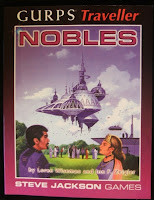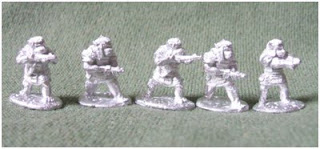
I have always felt that the table of Noble titles, as presented in
Classic Traveller, was a little too flat. A successful Naval Officer for example, could become a Duke before entering play. And realistically, there’s little chance His Grace would then be hanging around in seedy starport bars with his deadbeat mercenary chums, hustling for cargo for his Free Trader. The guy in charge of a planet, or a system, or several planets a) wouldn’t be allowed to do such a thing; b) would be too busy; and c) it probably wouldn’t occur to him to become a merchant in the first place – except, perhaps, at the boardroom level.
Looking at ways to curb potential power gamers (“I’m the Duke, I want that battlecruiser, I want it painted puce, and I want it now”) while allowing me the freedom to have noble player characters in my
Traveller campaign, I began to consider what part the Nobility actually plays in
Traveller. There are few clues in the
Little Black Books and
Supplement 4 and few pointers elsewhere in

canon until you reach the very fine
GURPs Traveller: Nobles supplement. From the Science Fiction that inspired Traveller,
The Mote in God’s Eye by Larry Niven and Jerry Pournelle reads as if it was a major source both for
Traveller and the role of the
Traveller nobility, while H. Beam Piper’s
Star Viking, and the
Federation and
Empire collections of short stories, and Poul Anderson’s Dominic Flandry stories offer further insights and inspiration.
In the end, it was Frank Herbert’s
Dune that lead me to envisage a two-tier form of nobility – the Siridar or Great Nobility, the Houses Major, who rule entire planets, systems and groups of planets; and the Houses Minor who hold fiefs on planets and make up the planetary banking, industrial, military, political and scientific elites. This also fitted in with my concept of how the RimWorlds were settled and developed. In this concept, the initial exploration and settlement was very much driven by a Private Venture Capital Company, in the fashion of the Merchant-Adventurers of Terra’s Sixteenth Century. Scions of Noble Houses put capital and resources into the exploration company and, in return, received planets, systems and clusters in fief to the leader of the expedition who, with the support of his nobles, became the first Sector Duke.
Politics in the RimWorlds, at the planetary, subsector and sector levels anyway, is very much like that of Belisarius and the Foederati of Sixth Century Byzantium, in that factions form around strong, powerful leaders and grow, or decline, as the perceived status of the leader alters through time. Vargr xenologists find this behaviour rather predictable.
Rules for Noble Player CharactersPlayer Characters who roll a high Social Status characteristic, or end up with high Social Status due to the Character creation process, are from a House Minor.
The Social Status ranks for Houses Minor:
Knight (B)
Baron (C)
Marquis (D)
Count (E)
Houses Minor that advance beyond the rank and title of Count have been elevated to House Major Status.
The Social Status ranks for Houses Major:
Siridar-Lord (B)
Siridar-Baron (C)
Siridar-Marquis (D)
Siridar-Count (E)
House Major ranks extend beyond those of Houses Minor as follows:
Duke (F)
Sector Duke (G)
Arch-Duke (H)
Emperor (J)
House Major ranks have the same titles as House Minor ranks, but with the prefix ‘Siridar’ – ‘Great’. The one exception is that of Social Status B Knight. The corresponding House Major title is Siridar-Lord and is the lowest rank of the Great Nobility to be assigned rulership responsibilities for an entire planet. Very few Siridar-Lords actually hold such positions and to many Houses Minor, merely obtaining the status of Siridar-Lord is the culmination of decades or centuries of effort. It should be noted that the titles of Duke (usually the short form of either Subsector or Sector Duke) and Archduke are not available to Houses Minor in the Imperial Rank system. Consequently, there is no need to prefix the title with ‘Siridar’ because if one is fortunate enough to encounter an individual of this rank, then one should be assured that one is in the presence of the ruler of a Subsector, a Sector or a Domain and act accordingly.
The elevation of a House Minor to House Major status can occur in one of several ways: Meritorious Service - a member of the House Minor has performed some service of such value that a House Major will stand sponsor for the House Minor’s elevation before the Conclave of Houses Major; Marriage Alliance – a House Minor successfully marries into a House Major and then inherits the House Major’s title and estates upon the failure of the direct line. Such successions usually set off lengthy court battles as any House Major heirs, of any remove, would seek to block the elevation of parvenu blood in such a fashion; Wealth & Power - a House Minor has accumulated sufficient wealth, prestige and political power to literally buy a House Major to stand sponsor for the House Minor’s elevation. Meritorious Service and Wealth & Power are the two most common means by which Houses Minor elevate themselves to House Major status.
Finally, a system for assigning benefits to nobles by Ian MacKinder, based on the articles ‘
Sceptre and Starship' and ‘
Robe and Blaster' by Ahnre and Stuart, and located on Ian’s
Website. I have not fully explored all the ramifications but I would look at either increasing the number of benefit rolls for Houses Major, or look at smoothing the results while importing some of the results from
GURPs Traveller: Nobles.
An example: Sir James Fabian Fairweather, a Naval Officer from Kartivia/Gazul, was invested with the Barony of Lukaskow on Kartivia in 982 by Liarb IX, Duke of Gazul. Now styled Baron Lukaskow, James had lifted House Fairweather’s status from where it had languished, as mere knights, for some three centuries. An ironic element of the investiture was that the Fairweathers were descended, on the distaff side, from House Crensea, Siridar-Counts of Daxam. House Crensea eventually numbered Dukes of Gazul, and Sector Dukes of the RimWorlds amongst their members. Duke Liarb IX of Gazul, a Crensea, was in fact a (very) distant relative of Baron James. The Fairweathers eventually acquired both the Marquisate of Chaquarg and the Barony of Holon on Kartivia, and by the Twelfth Century (current campaign date) had become a fairly wealthy and influential House Minor on their homeworld, with a Social Status of D in the senior line (the Marquis of Caquarg).
 A chap on the Stargrunt-Full Thrust Yahoo discussion group wanted to know how large the new 15mm Cyclops Battle suits from Ground Zero Games were. The short answer is that the battle suits stand about 30mm tall, or approximately 12' or 4 meters tall in RL.
A chap on the Stargrunt-Full Thrust Yahoo discussion group wanted to know how large the new 15mm Cyclops Battle suits from Ground Zero Games were. The short answer is that the battle suits stand about 30mm tall, or approximately 12' or 4 meters tall in RL. Here are a couple of WIPs comparing the battle suit with 15mm figures from Ground Zero Games and a 25mm Samurai from Eureka Miniatures (the only 25mm figure I have to hand).
Here are a couple of WIPs comparing the battle suit with 15mm figures from Ground Zero Games and a 25mm Samurai from Eureka Miniatures (the only 25mm figure I have to hand). Just remembered to snap a shot of the battle suit along side one of my Sydites - up until now the largest figures in my Traveller collection (well, non-vehicle figures). I think I had worked the Sydites out at twice man-height (which is a little larger than in the T20 rule book, but the Sydites in the RimWorlds eat all their greens and that's why they're so tall). The Cyclops tops them in height, and bulk.
Just remembered to snap a shot of the battle suit along side one of my Sydites - up until now the largest figures in my Traveller collection (well, non-vehicle figures). I think I had worked the Sydites out at twice man-height (which is a little larger than in the T20 rule book, but the Sydites in the RimWorlds eat all their greens and that's why they're so tall). The Cyclops tops them in height, and bulk.








































.png)









